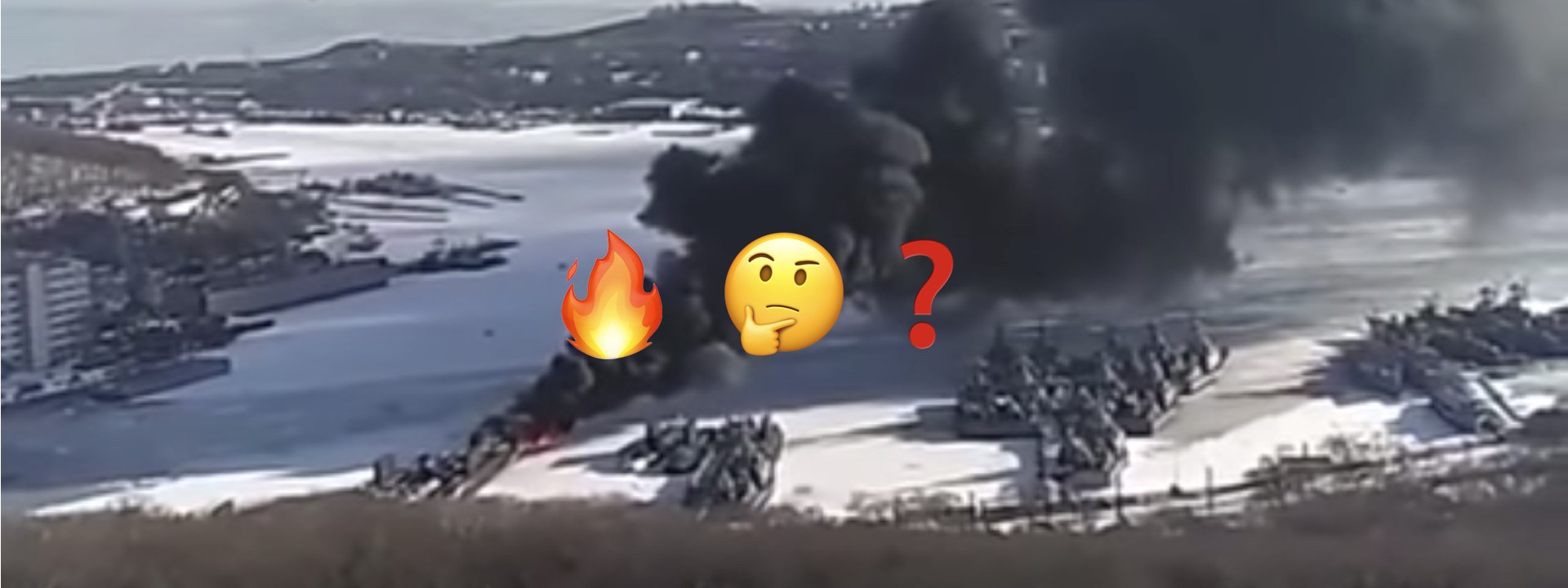#PutinAtWar: Blaze of Glory?
A closer look at the Russian submarine fire in the port of Vladivostok
#PutinAtWar: Blaze of Glory?

A closer look at the Russian submarine fire in the port of Vladivostok

The Bay of Ulysses in Vladivostok was filled with thick black smoke coming from the Russian Pacific Fleet docks on January 21. The Pacific Fleet’s press service released a statement the same day, which claimed that sailors were training how to extinguish a fire on the pier. While the official statement congratulated the sailors for their preparedness to act in extreme situations, civilian videos from the scene tell a different story. @DFRLab took a closer look to see what details were not mentioned in the official account.
Overview
The first videos of the incident appeared on YouTube as early as 8:11 UTC and were soon followed by VKontakte (VK or ВКонтакте) posts. Three videos of the accident appeared on YouTube and VK, which provided footage of the bay from three different angles. Thick black smoke and open flames were clearly visible in all of the videos and no clear signs of efforts to extinguish the fire were visible. At 10:40 UTC, Russian news agency TASS published the official statement of the incident, claiming that this was only a damage control exercise.
On the territory of the submarines of the Pacific Fleet (Bay of Ulysses), the personnel were trained to extinguish the fire on the pier, using imitations. The fire was extinguished in six minutes, the exercise took about 30 people. The personnel handled the situation outstandingly.
According to TASS, the local civilian fire brigades were not informed of this incident and were not present at the scene.
The three vantage points of civilian videos, which provided further information, are pinpointed below.
Video #1
The first video appeared on YouTube on 9:51 UTC. This video most likely originated on Instagram, but was soon removed.
The video gave a panoramic view of the Bay of Ulysses (Бухта Улисс), and confirmed the location of the accident in the southeastern part of Vladivostok.

In the video, the Russky Bridge was visible on the right and the ship assembly docks of the company Elling (Эллинг) was seen on the left. This video also gave away the actual spot of the fire — a pier (marked light blue in the picture below) on the northern side of the bay.

The video also zoomed in for a few seconds and provided a better view of the fire itself. The improved view revealed a submarine docked adjacent to the flames. Most likely, the submarine itself was on fire. Some articles detailing the incident claimed this is the Kilo-Class submarine — Project 636 “Varshavianka” (“Варшавянка”), visual details from the video suggested that this statement was true.
In the video, the distance from the fire to the sail of the submarine was roughly the same as the height of the actual sail. Overlaying the approximate measurement from the video over the blueprint of the Project 636 submarine, we observed the flames came from the rear end of the vessel. The flames appeared not to be coming from the pier, as mentioned in the TASS statement. No efforts to extinguish fire are evident in this video.


Video #2
The second video appeared on YouTube on 8:11 UTC. This video was most likely taken by one of the dock workers, since the video was taken on the Elling Company dock.
In the video, one of the crane legs and the back of the ship docked next to it were visible. The video was taken from a close distance, and — again — it showed the flames at the back of the submarine, rather than on the pier. The person who took the video commented on the scene in Russian:
“Here’s how a burning submarine looks like…”
No sailors allegedly involved in a fire extinguishing exercise were observed in this video.

Video #3
The last video appeared in an article written by Komsomolskaya Pravda (Комсомольская правда). The video did not appear on YouTube, therefore the exact upload time can not be traced.
https://www.dv.kp.ru/daily/26784.5/3818092/
This video was shot from the southern part of the Bay of Ulysses and did not provide many details. Nonetheless, this video confirmed the location of the fire on the northern side of the bay and corroborated the fact that the first video was not fake. Again, no personnel involved in a fire fighting exercise were observed in this video.

The density of the smoke and the size of the fire looked similar to previous Russian submarine accidents. One of the more recent accidents took place in Severodvisnk, in April 2015.
Kilo-Class submarines do have a history of accidents, especially in India. For example, a recent accident took place in 2013, when an fire erupted and caused an explosion on the INS Sindhurakshak, killing 18 crew members.
Conclusions
The press service of the Russian Pacific Fleet was quick to release the statement in response to the incident, but the official account was found wanting. The accident took place in the middle of Vladivostok, so civilian videos emerged before the official statement, this allowed us to get a better idea of what actually happened.
In-depth analysis corroborated a different set of facts. Specifcally, video evidence included more conclusive evidence that it was, in fact, the Project 636 submarine that caught fire rather than the pier. The statement provided by the Pacific Fleet seems to be yet another story pushed by the Russian military to avoid embarrassment.
@DFRLab will continue monitoring Russian military developments and exercises.
Follow along for more in-depth analysis from our #DigitalSherlocks.

